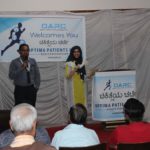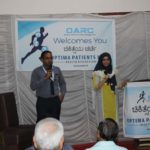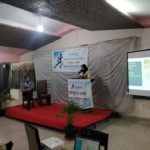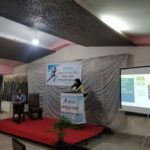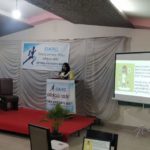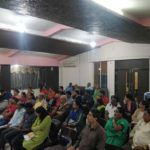The prospect of a muscle disease worries some people because they are afraid of not being able to walk. Yet in many cases, treatment exists for myopathy (muscle disease). Proper diagnosis and treatment raise the chance of living life fully despite this illness.
Fast Facts
Myopathy almost always causes loss of muscle strength.
Some patients also have rashes or breathing problems, or both.
While there is no cure for myopathies, treatment is most often effective. Following your doctor’s treatment plan is key to having a good outcome.
What are myopathies?
Myopathy is the medical term for muscle disease. Some muscle diseases occur when the body’s immune system attacks muscles. The result is misdirected inflammation, hence the name inflammatory myopathies. This damages muscle tissue and makes muscles weak.
People with inflammatory myopathies may have these features:
Weakness in the large muscles around the neck, shoulders and hips
Trouble climbing stairs, getting up from a seat, or reaching for objects overhead
Little, if any, pain in the muscles
Choking while eating or aspiration (intake) of food into the lungs
Shortness of breath and cough
The inflammatory myopathies include polymyositis and dermatomyositis. Muscle inflammation and weakness occur in both conditions while patients with dermatomyositis also have a rash. This rash most often appears as purple or red spots on the upper eyelids or as scaly, red bumps over the knuckles, elbows or knees. Children with the disease also may have white calcium deposits in the skin called calcinosis.
Sometimes patients can have the rash with no sign of muscle disease. Doctors call this form of the disease amyopathic dermatomyositis. People with dermatomyositis (/IAmA/PatientCaregiver/DiseasesConditions/DermatomyositisJuvenile) may also have lung inflammation that causes cough and shortness of breath. Children with the disease may have an inflammation of the blood vessels (vasculitis (/IAmA/PatientCaregiver/DiseasesConditions/Vasculitis)) that can result in skin lesions.
Some doctors group a health problem called inclusion body myositis with the inflammatory myopathies. Yet, it differs from them. Men get it more often than women, and the patients tend to be older. Most of these patients do not respond to standard treatment. Therefore, this fact sheet will not discuss this disease.
What causes myopathies and who gets them?
There are many causes of muscle disease. They include infection, muscle injury due to medicine, inherited diseases that affect muscle function, disorders of electrolyte levels, and thyroid disease. We do not know what causes inflammatory myopathies. A top theory is that something goes wrong in the immune system that leads to inflammation. This damages muscle cells or the blood vessels that are in the muscle.
Inflammatory myopathies are rare. Polymyositis and dermatomyositis occur in about one person per 100,000.
All ages can get these diseases. The peak time to get them, though, is ages 5 to 10 in children, and 40 to 50 in adults. Women get inflammatory myopathies about twice as often as men. These diseases affect all ethnic groups. No one can predict who will get an inflammatory myopathy.
How are myopathies diagnosed?
A doctor suspects myopathy when patients complain of trouble doing tasks that require muscle strength, or when they get certain rashes or breathing problems. Most people with myopathy have little or no pain in their muscles. This differs from other health problems. Examples are other forms of muscle disease, joint pain due to arthritis and nerve problems that cause numbness or tingling in the hands and feet. Many patients with other illnesses think they feel weak. In fact, they are tired, short of breath or depressed, rather than having true muscle weakness.
A doctor will do a muscle strength exam to find if true muscle weakness is present. The following test may then be needed:
A blood test to measure the level of various muscle enzymes
An electromyogram — often referred to as an EMG— to gauge electrical activity in muscle
A biopsy of a weak muscle (a small piece of muscle tissue is removed for testing)
Magnetic resonance imaging — more often called MRI — to try to show abnormal muscle
Some patients may have a blood test for myositisspecific antibodies (immune proteins). This test helps detect myopathy. It also gives some information about prognosis (how serious the disease is). In adults, dermatomyositis and, to a much lesser extent, polymyositis at times may be linked to cancer. Therefore, all adults with these diseases should have tests to rule out cancer.
How are myopathies treated?
You need a correct diagnosis of myopathy to have the best possible outcome. Rheumatologists are doctors who are experts in diagnosing and treating diseases of the muscles, joints and bones. Therefore, they are more likely to make a proper diagnosis of myopathy. They can also advise patients about the best treatment options available. Doctors most often treat these diseases with medications. Some of the most common treatments are as follows:
Corticosteroids: Often, the first treatment is an oral (by mouth) corticosteroid, such as prednisone, at a highdose. This reduces inflammation. Blood muscle enzymes tend to return to normal about 4−6 weeks after treatment starts. Most patients regain muscle strength in 2−3 months.
Combination treatment: Your doctor likely will add another drug to your treatment plan:methotrexate (/IAmA/PatientCaregiver/Treatments/MethotrexateRheumatrexTrexall) or azathioprine (/IAmA/PatientCaregiver/Treatments/AzathioprineImuran). This gives better longrange control of the disease and helps avoid longterm side effects of corticosteroids. These side effects include weight gain and redistribution of body fat, thinning of the skin, osteoporosis (/IAmA/PatientCaregiver/DiseasesConditions/Osteoporosis) and cataracts. Even muscle weakness can be a side effect. Because patients taking prednisone are at risk for osteoporosis, they should receive proper treatment to prevent it.
Immune treatments: Patients whose disease is severe or who do not respond to standard treatment haveother options. They include intravenous immunoglobulin — sometimes referred to as IVIg — or medicines that suppress the immune system. These immunosuppressive drugs include cyclosporine (/IAmA/PatientCaregiver/Treatments/CyclosporineNeoralSandimmuneGengraf) (Neoral,Sandimmune), tacrolimus(Prograf), mycophenolate mofetil (/IAmA/PatientCaregiver/Treatments/MycophenolateMofetilMycophenolateSodium) (CellCept) and rituximab (Rituxan) (/IAmA/PatientCaregiver/Treatments/RituximabRituxanMabThera).
Physical therapy: Physical therapy can help patients with muscle disease go on leading active lives. Physicaltherapy and exercise are important in the treatment of muscle disease. Very weak patients who do not walk should receive range of motion exercises. These exercises prevent joint contractures (deformity of the joint). Patients with medium weakness should start an exercise program to strengthen their muscles. The goal is to slowly increase in intensity as the patient regains strength. Mildly weak patients should take part in their normal activities.
Living with myopathy
Myopathies are chronic (longterm) diseases. To help control your illness, it is important to practice good health measures. Eat a healthy, wellbalanced diet, exercise and try to keep a healthy weight.
If you have a dermatomyositis rash, protect yourself from the sun. This is because the rash gets worse after sun exposure, for reasons that are not clear. Therefore, limit time outdoors, and put on sunscreen when you go outside.
If you have trouble swallowing, eat soft or semisolid foods, or puree your solid foods. To prevent choking if you are bedbound, you should be seated up in bed to eat.
People with myopathy may look healthy and normal. It is important for employers, teachers and family members to understand the limits that muscle weakness causes in people with myopathy.
Updated May 2015. This information was written by Marc Miller, MD, and reviewed by the American College of Rheumatology Communications and Marketing Committee. This information is provided for general education only. Individuals should consult a qualified health care provider for professional medical advice,
diagnosis and treatment of a medical or health condition.
© 2015 American College of Rheumatology
© 2015 American College of Rheumatology. All rights reserved.




